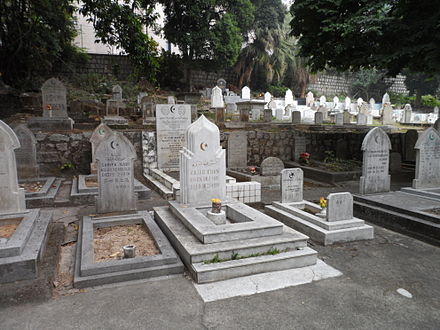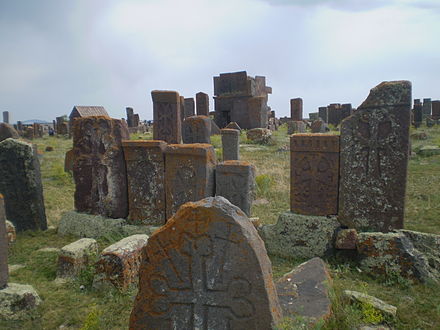Cemeteries
Cemeteries
A cemetery is any place with graves, tombs and memorials. The range of types and appearances is vast, from extensive mausolea with huge architectural elaborations, to unmarked plots of ground with hardly a sign it is a resting place.
In some cases royal memorials and tombs (see monarchies) may be the central point of vast grounds that might not always be known as a cemetery as such. Such sites are extensively visited for a wide range of reasons, depending on the local or national culture, they might be pilgrimage sites as well.
Pilgrimage
Some countries have extensive pilgrimage systems. Cemeteries and the tombs of special people within a religious or national context are connected with others. Sometimes the networks are well mapped and signed, others more mysterious and less obvious.
To complicate the issue, some areas and places have very different ideas about pilgrimage, and deny the veracity of the process. People can be told 'no there is no special grave here', or even directed to not consider graves or tombs to be suitable to visit at all.
The important part of becoming involved in pilgrimage is to research first. To make sure the cemetery or tomb is an acceptable place to visit and that there are no prohibitions.
Some grave complexes have elaborate procedures for visitors to comply with, with restrictions on visiting times, and clothing. In some countries, where hierarchical social and political strictures exist, some graves can even be off limits, or distanced from public access.
Walls and structures
Some cemeteries in built up areas have massive walls and fences for protection from vandalism. The walls and the surrounding structures can say more about the history of the location than the actual tombs.
In earlier times the walls and structures surrounding may have been built in relation to beliefs about things leaving the cemetery, as much as entering.
The leave-no-trace principle is the same as for archaeological sites. The legal consequences for trespassing in restricted areas, damaging graves, or souveniring artifacts from graves might be harsh. Respect the laws and regulations of local authorities.
Respect
Some cultures have very distinct beliefs about how or how not to visit graves, and it is well worth checking out acceptable practices.
For instance some places have strict rules on not walking over or touching a grave or its coverings.
Some places also have specified clothing types for people entering, in most cases pieces of clothing are available to hire at entries, or items considered not suitable can be kept at the entrances.
Avoid taking photographs of grieving people.
Information and genealogy
Some cemeteries have custodians or caretakers who have information about the place or know where information can be found.
Some cemeteries have museums, organised tours and guidebooks for tourists to find the graves of famous and significant people.
Many older cemeteries and grave sites that are archaeological sites as well.
Due to the pressures of genealogical enthusiasms some cemeteries are able to provide burial lists and details.
However, weathering of gravestones or headstones can wash away all information, and for some places, the site is so old, there are simply no people or publications available about the deceased buried there.
Funerals
The opportunity to be 'on site' during an important person's funeral or funeral procession can be a very special insight into a country or culture's attitude to people and their death.
High status people in some countries have such elaborate funerals that to be a witness is something that is very memorable.
There are usually protocols as to how close to death the funeral process is held, some events of burial are very close to death. Others require delays in numerical or calendrical auspiciousness.
Included in the protocols are the orders of precedence who precedes who in the sequence of mourners, some mausoleums and cemeteries have illustrations of the mourning processions of earlier deaths, where each allocated position in the mourning procession is identified.
Buy
There are limited ranges of cemetery souvenirs: usually guide books. Some cemeteries have meticulous and elaborate guides.
Famous cemeteries
Africa
- City of the Dead.
Americas
- Argentina:
- Brazil:
- St. John the Baptist Cemetery. Where important famous people who died in Rio de Janeiro are buried, including nine former presidents of Brazil and important musicians (such as Tom Jobim), writers (such as José de Alencar and Machado de Assis) and famous actresses (such as Carmen Miranda).
- Mexico:
- Mexico City National Cemetery.
- Janitzio Cemetery. Famous for its Day of the Dead celebrations
- United States:

- Arlington National Cemetery.
- Cahokia Mounds State Historic Site.
- Hillside Memorial Park Cemetery in Culver City
- Saint Louis Cemetery in New Orleans/Tremé, three cemeteries with 18th and 19th century aboveground tombs.
- Los Angeles National Cemetery (Los Angeles/West), occupying more than 100 acres.
- Cave Hill Cemetery (Louisville), Victorian-era National Cemetery occupying 300 acres.
- Woodlawn Cemetery (Bronx, New York City). National Historic Landmark covers more than 400 acres.
- Green-Wood Cemetery (Brooklyn, New York City). National Historic Landmark and Revolutionary War battleground covering nearly 500 acres.
Asia



- China:
- Babaoshan Revolutionary Cemetery in Beijing
- Cemetery of Confucius (Kong Lin, Qufu)
- Hong Kong Cemetery in Hong Kong
- Macau Muslim Cemetery in Macau
- Old Protestant Cemetery in Macau
- Zhalan Cemetery in Beijing
- Thirteen Ming Imperial Tombs in Beijing
- Eastern Qing Tombs near Tangshan, Hebei
- Western Qing Tombs near Baoding, Hebei
- India:
- Indonesia:
- Israel:
- Mount of Olives, ancient famous cemetery in Jerusalem with ancient funerary monuments.
- Mount Herzl National Cemetery, Jerusalem
- Sanhedria Cemetery, ancient cemetery of the Sanhedrin, in Jerusalem
- Yarkon Cemetery in Petah Tikva, the new Pantheon of famous people.
- Trumpeldor Cemetery famous cemetery in Tel Aviv of famous people from the 19th century.
- Kiryat Shaul Cemetery in Tel Aviv.
- Japan:
- Philippines:
- Heroes Cemetery in Taguig
- South Korea: Seoul National Cemetery in Seoul.
- Thailand: Royal Cemetery in Bangkok
- Turkey:
- Turkish State Cemetery in Ankara, with its monuments recalling the ancient Turkish structures of Central Asia, is where many major civilian and military figures of the republican era were interred, although notably Anıtkabir, the mausoleum of the founder of the republic, Kemal Atatürk, is a separate site.
- Karacaahmet Cemetery between Üsküdar and Kadıköy on the Asian Side of the Bosphorus in Istanbul, an expanse of of cypress woodland, is the largest Turkish cemetery and its foundation in the 14th century predates the Fall of Constantinople.
- A footpath from the banks of the Golden Horn in Istanbul cuts through the Eyüp Cemetery, an Ottoman-era burial ground where the tradition dictates that the marble headstones of men are topped by a turban while those of women have floral designs. A gondola lift line passes over part of the cemetery as well.
- The massive and highly elaborate tombstones at the Ahlat Cemetery (on the Lake Van near Tatvan), carved out of local volcanic rocks, date back to the local Ahlatshah Kingdom of the 11th–12th centuries and are typical of the medieval Turkish art.
- Gallipoli hosts several military cemeteries of soldiers from Turkey and the Commonwealth nations (Australia and New Zealand in particular) fallen during the Gallipoli Campaign of World War I.
Europe
- Armenia: Noratus Cemetery, near Sevan on the lake of the same name, has the world's largest collection of khachkars – Armenia's massive, highly elaborately carved traditional headstones with a cross in the centre.
- Austria: Vienna (see Culture section about Death, and Zentralfriedhof)
- Balkans: Stećci Medieval Tombstones Graveyards
- Bulgaria: Central Sofia Cemetery in Sofia
- Croatia: Mirogoj Cemetery, Zagreb
- Czech Republic: Old Jewish Cemetery, Vyšehrad Cemetery (Prague)
- Finland: Hietaniemi Cemetery, Helsinki
- France:
- Père Lachaise Cemetery Paris/20th arrondissement
- several cemeteries in Normandy, near the D-Day beaches
- Greece:
- First Cemetery in Athens (Athens)
- Hungary:
- Kerepesi Cemetery in Budapest
- Italy:
- Poland: National necropoles: Powązki in Warsaw and Rakowice in Kraków, Pęksowy Brzyzek National Cemetery in Zakopane
- Portugal: Cemetery of Pleasures (Cemitério dos Prazeres) in Lisbon
- Romania: Merry Cemetery in Săpânța, Maramureş; Ghencea Cemetery in Bucharest.
- Russia: Novodevichy Cemetery (Moscow); Shirokorechenskoye Kladbishche Cemetery (Mafia cemetery, Yekaterinburg)
- Sweden: Woodland Cemetery (Skogskyrkogården, Stockholm/Söderort), a world heritage site.
- Ukraine: Lychakiv Cemetery (Lviv); Grave of Rabbi Nachman of Breslov in Uman, a major site of Chasidic pilgrimage
- United Kingdom: Stonehenge, Highgate Cemetery (London), Brookwood (Woking)
Oceania
- Australia:
- Gore Hill Memorial Cemetery in Sydney/Lower North Shore
- Macquarie Park Cemetery in Sydney/Macquarie Park
- Melbourne General Cemetery in Melbourne
- Old Nambour Cemetery in Nambour
- Toowong Cemetery in Brisbane
See also
Related Wikipedia article: Tombstone tourist
